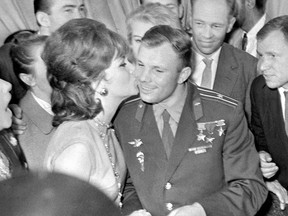Barred from spaceflight after becoming the first man in space, Yuri Gagarin was 34 when he died in a routine training flight
Article content
On this date, April 12, in 1961, Yuri Gagarin rocketed into space and history as the first human to orbit our planet. Yet more than 60 years later, his subsequent death remains something of a mystery.
Gagarin lifted off from Baikonur Cosmodrome in Kazakhstan, U.S.S.R., and reached an altitude of about 325 kilometres on a single orbit that lasted less than two hours before he landed — far off course but still in the Soviet Union — in front of a young girl and her grandmother. They were terrified.
Advertisement 2
Article content
Article content
The mission was a blow to the United States, which was far behind in the space race. The Soviets had already beaten them into space with the first satellite, and would also put the first woman in space and conduct the first space walk before America managed to overtake them and make the first manned landing on the moon.

Gagarin was given a hero’s welcome, but was subsequently barred from going to space again, because the Soviet leaders did not want a national hero to die on a future mission. But less than seven years later, when he was just 34, the cosmonaut would be killed during a routine training flight in his MiG-15 jet near the Chkalovsky aerodrome just outside Moscow.
Several years ago, fellow cosmonaut and colleague Vladimir Aksyonov, who died this week at the age of 89, spoke to news agency Agence France-Presse about the events of March 27, 1968, when he was also supposed to be flying.
“Yuri and I consulted the same doctors and listened to the same weather forecasts; my takeoff was due an hour after his,” the retired cosmonaut recalled.
But Aksyonov’s flight was cancelled, and later that morning, Gagarin and his co-pilot, Vladimir Seryogin, were no longer responding to radio calls. A few hours later, helicopter crews searching for the plane said they found parts of the wreckage 65 kilometres from the aerodrome.
Article content
Advertisement 3
Article content

Gagarin’s body was recovered the next day. It was a shock to the nation, which declared a day of national mourning for the cosmonaut, the first time such an honour had been given to someone who was not a head of state.
According to the official report on the incident, the plane had to make a sudden manoeuvre because of a “change in the situation in the air,” which led to the crash.
But Alexander Glushko, a historian of the Soviet space industry, told AFP: “The report of the official commission, which was 29 volumes, was never published. This pushed colleagues and experts to start their own research.”
That of course led to rumours, including that Gagarin had been killed by the KGB; that he had been drunk; or that he had been abducted by aliens. In 2011, the 50th anniversary of his spaceflight, newly declassified documents said Gagarin or Seryogin had manoeuvred sharply, either to avoid a weather balloon or to avoid “entry into the upper limit of the first layer of cloud cover,” leading the jet into a “super-critical flight regime and to its stalling in complex meteorological conditions.”
Advertisement 4
Article content
Then there is the second plane theory. Cosmonaut Alexei Leonov, a member of a commission investigating Gagarin’s death, was conducting parachute training sessions that day and heard “two loud booms in the distance.” He believed another aircraft passed within 10 or 20 metres of Gagarin’s plane while breaking the sound barrier, and that the resulting turbulence sent the MiG into an uncontrolled spin. The first boom he heard was the jet breaking the sound barrier; the second was the crash.
Recommended from Editorial
In 2017, Leonov, then 83, told state news agency RIA Novosti: “I saw a declassified document of the investigation that confirmed (this).” He added that the commission had covered up the truth to protect the other plane’s pilot, whom he refused to name but referred to as “quite famous” and currently “old and sick.”
He concluded: “This is no longer a secret: it is about negligence and a violation of aviation rules.” Leonov died a year later, in 2019. The space-age mystery continues.
Article content








